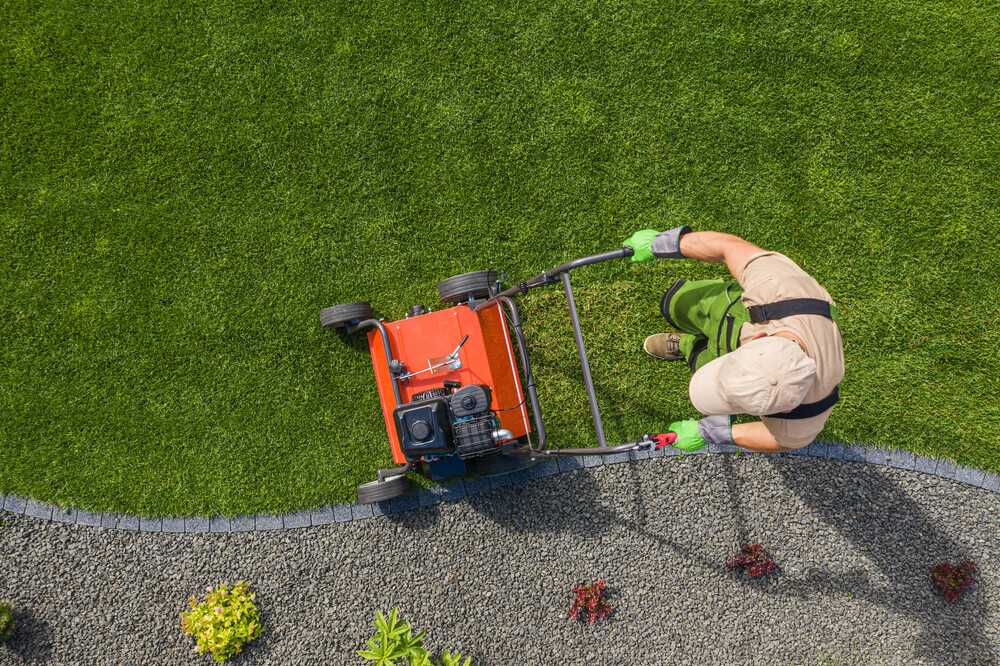The Ultimate Guide to Aerating Your Lawn: When is the Best Time to Ensure a Lush and Healthy Yard?
If you’re looking to achieve a lush and healthy yard, proper lawn maintenance is key. One essential practice that often gets overlooked is lawn aeration. By ensuring your lawn is properly aerated, you can create the optimal environment for your grass to thrive. But when is the best time to aerate your lawn?
In this comprehensive guide, we’ll answer that question and more. We’ll dive into the benefits of lawn aeration, explaining how it promotes healthy root growth and allows your turf to absorb vital nutrients. We’ll also explore the different types of lawn aerators available and provide step-by-step instructions on how to aerate your lawn effectively.
Whether you’re a seasoned gardener or just starting your lawn care journey, this guide is for you. With our expert advice and practical tips, you’ll be able to confidently aerate your lawn at the perfect time, ensuring a vibrant and resilient yard that will be the envy of your neighborhood. Say goodbye to the brown patches and hello to a flourishing lawn – let’s get started.
What is Lawn Aeration?
Lawn aeration involves creating small holes in the soil to let air, water, and nutrients reach the grass roots. This process is key to maintaining a healthy, green lawn. Over time, compacted soil blocks air, water, and nutrients from properly reaching the roots. Aeration helps fix this by opening pathways for these essential elements, promoting stronger growth and a lush appearance.
The aeration process works by removing small plugs of soil from the lawn, leaving tiny holes behind. This loosens the soil, allowing oxygen, water, and nutrients to penetrate more easily. Aeration also reduces thatch buildup, a layer of dead and living plant material on the soil’s surface. Thatch can block essential elements from reaching the roots, causing a lawn to become less healthy and less visually appealing.
Importance of Lawn Aeration
Lawn aeration is essential for keeping your lawn healthy and vibrant. By aerating regularly, you can enjoy several key benefits:
Improved soil structure and drainage: Compacted soil can cause poor water absorption, leading to waterlogged spots. Aeration helps loosen the soil, allowing water to flow better and reducing standing water or muddy patches.
Enhanced nutrient absorption: When the soil is compacted, grass roots struggle to absorb vital nutrients. Aeration creates channels that let nutrients reach the root zone, giving your lawn the nourishment it needs to thrive.
Stronger, deeper root systems: Aeration promotes stronger root growth by improving access to air, water, and nutrients. This results in deeper roots and a more drought-resistant, resilient lawn.
Reduced thatch buildup: Thatch can block air, water, and nutrients from reaching the roots. Aeration helps break down the thatch layer, ensuring your lawn stays healthy and well-fed.
Improved overall lawn health: Aeration helps your lawn fight off disease, weeds, and other issues. A well-aerated lawn looks lush, healthy, and is sure to be the envy of the neighborhood!
Your lawn is going to look amazing with these practices in place! Keep up the great work!
Signs That Your Lawn Needs Aeration
Recognizing when your lawn needs aeration is key to keeping it healthy and thriving. Here are some signs that it’s time to aerate:
Compacted soil: If your lawn’s soil feels hard and dense, it may be compacted. Compacted soil blocks air, water, and nutrients from reaching the roots, which can result in an unhealthy lawn.
Shallow root systems: Check your grass roots. If they look shallow or stunted, the roots may be struggling to penetrate the soil. Aeration can encourage deeper, stronger root growth.
Excessive thatch buildup: A thick, spongy layer of thatch on the soil surface is a clear sign it’s time to aerate. Aeration helps break down thatch, allowing essential nutrients to reach the roots.
Poor drainage: Standing water or muddy patches after rain or watering indicate poor drainage. Aeration improves soil structure, helping water drain properly and preventing these issues.
Thin, patchy grass: Sparse or thin grass coverage often means compacted soil is preventing roots from getting enough nutrients and water. Aeration revitalizes the lawn, promoting thicker, healthier grass.
By watching for these signs, you can address soil issues and keep your lawn vibrant. Regular aeration, paired with proper lawn care, ensures your yard stays healthy and lush.
Different Methods of Lawn Aeration
There are several methods of lawn aeration, each with its own benefits and drawbacks. Understanding these options can help you choose the best one for your lawn. Here are some common lawn aeration techniques:
Core aeration: The most popular and effective method. Core aerators remove small plugs of soil, leaving tiny holes behind. This process improves soil structure, boosts nutrient and water absorption, and reduces thatch buildup.
Spike aeration: Spike aerators use solid spikes to puncture the soil, creating holes without removing soil cores. While it helps with air and water infiltration, it’s less effective than core aeration because it doesn’t remove compacted soil.
Liquid aeration: This method involves applying a solution that breaks down soil compaction and improves moisture penetration. It’s often used as a supplement to mechanical aeration and requires less physical labor.
Slice aeration: Slice aerators create narrow slits in the soil using flat blades. It’s less disruptive than core aeration, making it ideal for lawns with shallow or delicate root systems, though it may not be as effective for severe compaction.
Choosing the right method depends on your lawn’s size, soil compaction, and your preferences. You may even opt for a combination of these techniques to get the best results for your lawn.
Best Time to Aerate Your Lawn
Determining the best time to aerate your lawn is key to achieving great results. Timing can significantly affect your lawn’s health and appearance. Here’s a breakdown of the best times to aerate:
Spring aeration: Aerating in the spring, typically between March and May, is ideal. Warmer temperatures and increased moisture help the grass recover quickly. Spring aeration benefits cool-season grasses like fescue and bluegrass, which grow actively during this period.
Fall aeration: Aerating in the fall, usually from September to November, is also effective. The soil is more moist, making aeration easier, and the grass has time to recover before winter dormancy. Fall aeration is perfect for warm-season grasses like Bermuda and Zoysia, which are actively growing during this time.
Dual aeration: For optimal aeration, consider aerating in both spring and fall. This provides two chances for your grass to benefit from aeration each year. It’s especially helpful for lawns with heavy soil compaction or high foot traffic.
Regardless of when you aerate, ensure the soil is moist but not waterlogged. Aerating dry soil is less effective. By choosing the right time to aerate, you’ll enhance your lawn’s health and enjoy a lush, vibrant yard for years to come.
Preparing Your Lawn for Aeration
Before you begin the aeration process, there are a few important steps you can take to ensure the best possible results. Proper preparation can help to optimize the effectiveness of your aeration efforts and set your lawn up for success. With a little bit of pre-work, you’ll be well on your way to a lush, healthy yard. Here’s what you should do:
Mow your lawn: It’s best to aerate your lawn shortly after mowing, as this will ensure the aeration tines can easily penetrate the soil. Aim to mow your lawn a few days before the scheduled aeration to allow the grass to recover slightly.
Water your lawn: Proper soil moisture is crucial for effective aeration. Water your lawn thoroughly a day or two before the aeration process, ensuring the soil is moist but not waterlogged. This will help the aeration tines to easily puncture the soil and create the necessary holes.
Remove any debris: Before aerating, take the time to remove any debris, such as sticks, rocks, or leaves, from your lawn. This will help to prevent damage to your aeration equipment and ensure an even, consistent aeration process.
Mark any obstacles: If you have any underground utilities, sprinkler heads, or other obstacles in your lawn, be sure to mark them clearly. This will help you to avoid damaging these items during the aeration process.
Consider overseeding: If your lawn is thin or patchy, you may want to consider overseeding immediately after aeration. The holes created by the aeration process will provide an ideal environment for new grass seed to germinate and establish a stronger, more vibrant lawn.
Step-by-Step Guide to Aerating Your Lawn
Aerating your lawn may seem like a daunting task, but with the right tools and techniques, it can be a straightforward and rewarding process. Here’s a step-by-step guide to help you aerate your lawn effectively:
Choose the right aeration equipment: Depending on the size of your lawn and the specific needs of your grass, you may opt for a core aerator, spike aerator, or a combination of both. Consider renting or purchasing the appropriate equipment to ensure a successful aeration process.
Mark any obstacles: Before you begin, carefully inspect your lawn and mark any underground utilities, sprinkler heads, or other obstacles that you’ll need to avoid during the aeration process.
Mow your lawn: As mentioned earlier, it’s best to aerate your lawn shortly after mowing. This will ensure the aeration tines can easily penetrate the soil.
Water your lawn: Ensure the soil is moist but not waterlogged by thoroughly watering your lawn a day or two before the aeration process.
Start aerating: Begin aerating your lawn, working in straight, parallel lines to ensure even coverage. Overlap each pass slightly to create a consistent pattern of holes throughout the entire area.
Avoid wet or dry conditions: If the soil is too wet or too dry, the aeration process may be less effective. Aim to aerate when the soil is moist but not saturated.
Cover the entire lawn: Make sure to aerate the entire lawn, including any hard-to-reach areas or tight spaces. This will help to ensure a consistent, even distribution of holes throughout your yard.
Consider overseeding: If your lawn is thin or patchy, you may want to overseed immediately after aeration to take advantage of the newly created holes and encourage the growth of new grass.
Clean up: After the aeration process is complete, be sure to remove any debris or soil cores that may have been left behind on the lawn’s surface.
By following these steps, you can effectively aerate your lawn and create the optimal conditions for your grass to thrive.
Common Mistakes to Avoid When Aerating Your Lawn
While lawn aeration is a relatively straightforward process, there are a few common mistakes that homeowners can make that can undermine the effectiveness of their efforts. By being aware of these pitfalls and taking steps to avoid them, you can ensure that your aeration process is a success. Here are some common mistakes to watch out for:
Aerating at the wrong time: As discussed earlier, the timing of your aeration efforts is crucial. Aerating during the wrong season or when the soil is too wet or too dry can reduce the benefits of the process and even damage your lawn.
Using the wrong equipment: Choosing the wrong aeration equipment for your lawn’s specific needs can lead to suboptimal results. Be sure to select the appropriate core aerator, spike aerator, or combination tool for your grass type and soil conditions.
Failing to prepare the lawn: Neglecting to mow, water, and remove debris from your lawn before aeration can hinder the process and prevent the aeration tines from penetrating the soil effectively.
Skipping key steps: Overlooking important steps, such as marking obstacles or overseeding after aeration, can limit the long-term benefits of the process and leave your lawn vulnerable to problems.
Aerating too deeply: While deep aeration can be beneficial for heavily compacted soils, aerating too deeply can damage the grass roots and lead to an unhealthy lawn.
Neglecting aftercare: Failing to properly water, fertilize, and maintain your lawn after aeration can negate the benefits of the process and prevent your grass from fully recovering.
Overaerating: While regular aeration is essential, aerating your lawn too frequently can be detrimental, leading to an overly disrupted soil structure and potential damage to the grass.
Conclusion: Achieving a Lush and Healthy Yard Through Proper Lawn Aeration
Lawn aeration is a crucial component of any comprehensive lawn care regimen, and for good reason. By creating the optimal conditions for your grass to thrive, aeration can have a transformative effect on the health and appearance of your outdoor space.
Through this comprehensive guide, we’ve explored the benefits of lawn aeration, the signs that your lawn needs it, and the various methods available. We’ve also provided guidance on the best time to aerate, how to properly prepare your lawn, and a step-by-step process for effectively aerating your grass. Finally, we’ve discussed the importance of aftercare and the common mistakes to avoid, ensuring the long-term success of your aeration efforts.
By following the advice outlined in this guide, you’ll be well on your way to achieving a lush, healthy yard that will be the envy of your neighborhood. Remember, regular aeration is key!
Call PURCOR for Professional Help
Don’t like the way your lawn looks? Call PURCOR Lawn Care Services immediately for a professional assessment. Early intervention can prevent further damage and ensure your lawn remains healthy.
Visit our Lawn Care Services page for more details on how we can help you achieve a thriving lawn.
Request a Free Lawn Care Estimate from PURCOR
Your lawn deserves the best care to stay healthy and vibrant. With PURCOR’s expert lawn control services, you can tackle weeds, improve soil quality, and maintain lush, green grass. Give our team a call or request your free lawn care estimate online today.
"*" indicates required fields
"*" indicates required fields




